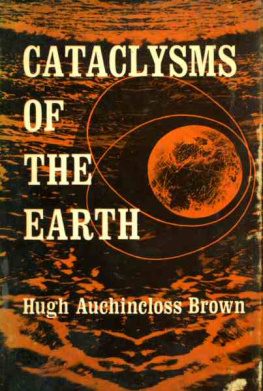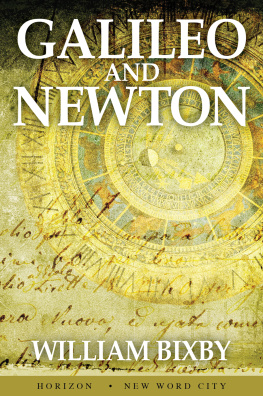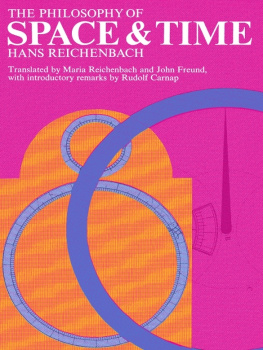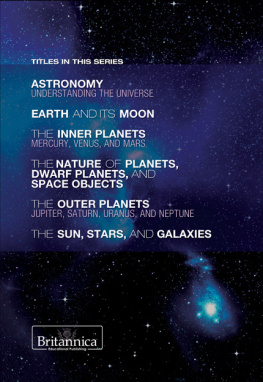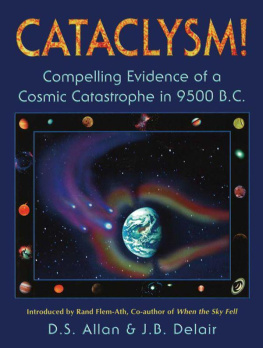Hugh Auchencloss Brown - Cataclysms of the Earth
Here you can read online Hugh Auchencloss Brown - Cataclysms of the Earth full text of the book (entire story) in english for free. Download pdf and epub, get meaning, cover and reviews about this ebook. year: 1967, genre: Children. Description of the work, (preface) as well as reviews are available. Best literature library LitArk.com created for fans of good reading and offers a wide selection of genres:
Romance novel
Science fiction
Adventure
Detective
Science
History
Home and family
Prose
Art
Politics
Computer
Non-fiction
Religion
Business
Children
Humor
Choose a favorite category and find really read worthwhile books. Enjoy immersion in the world of imagination, feel the emotions of the characters or learn something new for yourself, make an fascinating discovery.
- Book:Cataclysms of the Earth
- Author:
- Genre:
- Year:1967
- Rating:3 / 5
- Favourites:Add to favourites
- Your mark:
- 60
- 1
- 2
- 3
- 4
- 5
Cataclysms of the Earth: summary, description and annotation
We offer to read an annotation, description, summary or preface (depends on what the author of the book "Cataclysms of the Earth" wrote himself). If you haven't found the necessary information about the book — write in the comments, we will try to find it.
Cataclysms of the Earth — read online for free the complete book (whole text) full work
Below is the text of the book, divided by pages. System saving the place of the last page read, allows you to conveniently read the book "Cataclysms of the Earth" online for free, without having to search again every time where you left off. Put a bookmark, and you can go to the page where you finished reading at any time.
Font size:
Interval:
Bookmark:
We are all aware that our earth is constantly changing. By the roadside or in the mountains we notice the layers of rocks, or strata, displaced from their original horizontal plane, and recognize the evidence of the shifting of the earth's so-called crust In the cross sections of canyons we note the succession of layers-the permanent markings made by rock formation in earlier epochs. We uncover animal and plant fossils and by their depth and placement can construct a chronology of prehistoric life. The movement of the rivers carving out new beds and the pounding of the oceans on their shores all remind us of the endless motion of the land and seas.
These, however, are but the surface phenomena of the evolution of our globe. Barely do we speculate on the forces constantly reforming the planet as a whole; rarely do we speculate on the nature and the effects of major upheavals and cataclysms that, on a larger scale, have characterized the history of the earth. We are all aware of the great stone book that is our earth, but rarely do we read its pages. The origin of our planet remains a mystery; of its life history, inscribed upon itself, only minutiae are fully known to man.
The successive layers in the earth's crust reveal that the earth has not only undergone vast surface changes, such as the stratification of layers of rock and the formation of mountain ranges and river beds. On a much grander scale, the evidence suggests that the earth's axis of rotation has repeatedly changed its direction; during its journeys around the sun the earth has been rolling sideways as it spins in daily rotation, and shifting to a new Axis of Figure, i.e., the axis defining the geographic poles.
Such an axial shift can best be understood when considered in relation to the earth's rotation about the Axis of Spin the true axis of rotation in respect to the stars and irrespective of the surface terrain of the earth. The Axis of Spin is the imaginary line in space about which the earth rotates; it is constant in relation to the earth itself, but changes its position in space as described later. The Axis of Figure is an imaginary line through the center of the earth; it is defined by the arbitrary designation of the geographic poles, wherever they may occur during any epoch, and, being relative to the geography of the earth's surface, it changes whenever the earth shifts about the Axis of Spin.
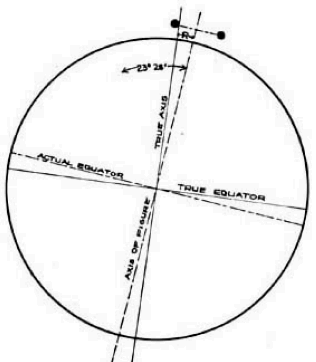
Fig. 1. Deviation between true axis and Axis of Figure.
Although the earth has continued to rotate on the Axis of Spin that passes through Polaris in the northern sky and the Southern Cross in the southern sky, it has in the course of time turned sideways or "careened" in its spinning; the geographic positions of the poles, the Equator, and the various zones of the globe, have been redefined in respect to the surface terrain. During such careening the Equator tilts, and the poles, defining the Axis of Figure, rotate away from the Axis of Spin. All areas of the globe, except those two points directly on the Axis of Careen, are altered in relation to the Axis of Spin, and hence in relation to their previous climates. A land mass or ocean, once in an equatorial zone, is shifted towards a polar position; the poles shift around towards the equatorial zones. The previous Axis of Figure is then replaced by a new one, determined by the new geography of the earth. At the beginning of each epoch, the Axis of Figure and the Axis of Spin coincide.
Fossils of animal and plant life from previous epochs serve as telltale indicators of the climate prevailing when the strata in which they are found formed the earth's surface. From fossils and other evidence we are able to document the displacement of materials from their native climates to areas of new and often alien climates and to designate the amount of displacement and the date of earlier careenings of the globe. From the condition of the evidence, we are able to suggest the cataclysmic forces that took effect at such time.
This evidence, however, provides us only with the symptoms of the forces at work on our planet. To fully understand why the earth has come to be as we know it, we must also analyze how it came to be that way.
We must construct a theory, consistent with all the data that we can collect, which will explain how such careenings have come about. And we must test this hypothesis by applying it to the earth as we presently know it.
Here again, all the evidence mentioned so far will serve as our guide. Indeed, the discovery of the recurrent careening of our globe resulted from efforts directed at solving the mystery of prehistoric animal life.
The value of any branch of science, even such a seemingly "backward" looking one as geology, lies not only in the knowledge we may gain about the past and the changes and developments that have occurred. For science to be of value in the present, for it to transcend the mere recording of the past and present, it must offer theories that are applicable to the future.
Years of investigation and research, coupled with resolution and courage to follow wherever truth might lead, have established the certainty of a future world cataclysm during which most of the earth's population will be destroyed in the same manner as the mammoths of prehistoric times were destroyed. Such an event has occurred each time that one or two polar ice caps grew to maturity; a recurrent event in global history it is clearly written in the rocks of a very old earth.
The earth is approximately 4 billion years old. Human beings have been living on it for at least 500,000 years and perhaps even one million years. To appreciate the immensity of these figures, one might imagine the age of the earth represented by the period of about one week; the duration of our own epoch, 7,000 years, is then but one second! By a similar analogy, men have lived on an earth that is one week old for just two minutes. It is evident that our own epoch is but a very short and insignificant period in the life of our planet and our species.
In past epochs there have been ice caps at one or both of the geographical poles. The heat of the sun caused these ice caps to grow larger. As the sun heats the air of the hemisphere, the heated air expands, becomes lighter, and rises. The updrafts are greatest in the tropics. As the earth is virtually spherical, the currents of warm air converge at the poles. Meeting head-on from every direction, they create areas of air pressure, become colder and heavier, turn downward, reversing the direction of their flow, and pour back toward the Equator from the polar centers with high velocities. Thus, there is a continuous circulation of rising humid warm air journeying pole-ward and a down-draft of cold dehumidified air returning from the poles at low or ground altitudes. Air acts like a sponge. When warm, it absorbs water; when cold, it cannot hold much water, and in cooling releases any surplus moisture to fall as rain or snow.
Most of the snow that falls in the polar regions does not melt; the air temperature is too low. Instead, the snow is stored, changing to glacial ice. As this process continues through time, the ice masses at the poles constantly grow in volume.
As the prehistoric ice caps grew larger, they tended to throw the rotating planet off balance because of the wobble of the earth, causing the earth to roll around sideways to its direction of rotation.
Another analogy will make this clear. When you place a weight at the end of a string and then rotate the string in a circle, the weighted end of the string rises to a horizontal plane. Now, imagine yourself and the string as the earth, the weight at the end of the string as the weight of a growing ice cap, and imagine that, instead of intentionally swinging the weighted string, the rotational motion encompasses you, the string and the weight, as though you were standing on a rotating platform. In this depiction, then, your body represents both the present Axis of Spin and Axis of Figure of the earth. Your body does not move; the Axis of Spin remains the same. But your arm and the weighted string, here representing a radius of the earth, rise from the vertical (directed towards the pole) to the horizontal (directed towards the Equator). The sphere of which your arm and the weighted string are a radius is rolled sideways; the weight, representing the imbalance of an ice cap, rotates from a polar position to an equatorial position. The Axis of Figure, previously represented by your vertical arm, is now changed; the old Axis of Figure is now perpendicular to the Axis of Spin.
Font size:
Interval:
Bookmark:
Similar books «Cataclysms of the Earth»
Look at similar books to Cataclysms of the Earth. We have selected literature similar in name and meaning in the hope of providing readers with more options to find new, interesting, not yet read works.
Discussion, reviews of the book Cataclysms of the Earth and just readers' own opinions. Leave your comments, write what you think about the work, its meaning or the main characters. Specify what exactly you liked and what you didn't like, and why you think so.

